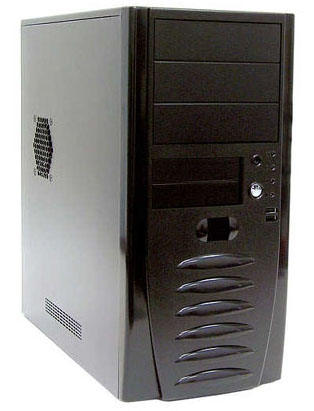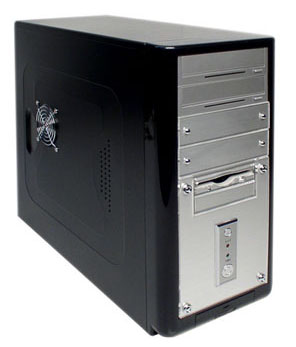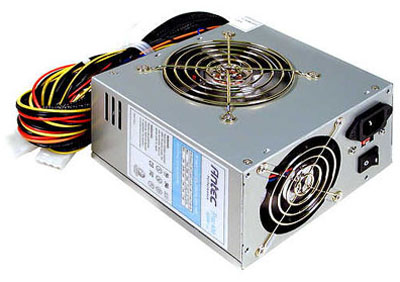Buyer's Guide - Entry Level, October 2004
by Jarred Walton on October 6, 2004 12:05 AM EST- Posted in
- Guides
Case and Power Supply
Tastes in case design are very personal. Some do not mind a "boring" beige case, while others have to have lights and windows and all sorts of other extras. Since this is a Budget Guide, truly exotic designs are not really possible, but that does not mean that we have to settle for ugly or boring. The choice of case is one area where there is not as much difference between the office and gaming recommendations. However, heat is more of a concern in a gaming system, so we recommend that whichever case you select, you should add in an extra case fan or even two, just to be safe.We like cases that are easy to work with, and the more frequently that you upgrade components, the more important such concerns become. If you typically build your system and then rarely open it other than to blow the dust out every three to six months - something that we highly recommend all computer owners do, as dust can literally kill your computer parts - ease of use might take a back seat to outward appearance. Most budget cases are going to be made out of steel and plastic, although you might find some less expensive aluminum cases if you look around. Steel cases are usually more durable, but they also weigh more and some may feel that they are less visually appealing. Then again, you can always change the look of any case by modding it.

Budget Case Recommendation: Antec SLK1650B with 350W PSU
Price: $73 shipped
Antec is well known for their power supplies and cases. While they may not be the cheapest case around, their quality is beyond reproach. There are currently several variants of the SLK series from Antec, with this being the cheapest model. It lacks the door of the 2600-BQE, which many people actually prefer. The case includes a whisper-quiet 120 mm temperature sensitive fan for the rear, and there is room to add an 80 mm fan at the front of the case for improved cooling. Also included is a plastic duct on the side panel, which will help your CPU to draw in cool air. The 350W PSU that comes with this case retails separately for over $40, so when you consider that, the Antec case becomes even more attractive. Although they may not be the flashiest cases on the planet, Antec sells cases that are easy to work with, quiet in operation, and simple, yet elegant. It is hard to match their price without sacrificing reliability and features.

Budget Case Alternative: Aspire Black Turbo Case ATXB2KL with 350W PSU
Price: $52 shipped
Our alternative case comes from Aspire, and we include it more as an example of the other options that exist as opposed to a real recommendation. You can also look at our past Guides for some other options. Aspire makes a variety of cases in terms of both styling and color. We have chosen the base model, but you could also choose a model with a window on the side, with or without lights, in blue, red, green, yellow, etc. The quality of Aspire cases is merely okay, which fits with our budget motif. They will not win awards for being the best cases available in the market, but it is difficult to argue with the price. If you are looking for other options, RAIDMAX is another company that offers similar quality and at similar costs.
The front of the case is silver with doors that flip down to allow access to the CD/DVD drives. This looks nice, but the covers can be somewhat difficult to get lined up properly with some optical drives. You can always remove the covers, but then the overall look of your system will be marred. Installing your components into this case may also take a little more time and effort, and the durability of the case is not very good. However, if you do not move your case around much and you (or your children) do not use it as a stool, it should be fine. The case comes with a 350W power supply (PSU), but it is basically a generic PSU and the usual disclaimers about getting what you pay for apply. Overall, we feel this is an attractive case with some problems, but it is offered at a very low price.
Power Supplies
While both cases include 350W power supplies, they are not necessarily equal. In the past, it may not have mattered what sort of PSU you used, but modern computers require more of their power supplies. Inconsistent power can cause system instabilities that are very hard to track down. Many computer enthusiasts will have a spare PSU available just to be safe. It is important to state that the advertised wattage for a power supply can be influenced by a number of factors, temperature being the greatest. Some units might list a 350W operating capacity that can only be achieved reliably if the temperature is 70 F or lower - this is not a common occurrence for the inside of a computer case.You also have to look at how the power is distributed. The CPU, RAM and motherboard components will stress the 3.3V, 5V and 12V output. Hard drives, optical drives and fans only stress the 12V lines. Graphics cards that require an additional power connection will also stress the 12V lines. The amperage that is available for each is actually more important than the wattage. In the end, what you see on the sticker attached to a power supply may or may not be realistic. If you can actually compare various power supplies, we recommend giving each the extremely scientific heft test: pick up the power supply, and compare their weights. Heavier units usually have higher quality components and are, thus, more reliable.
This brings us to a point that many people fail to consider: once you add in the shipping costs for ordering a case and power supply from an online reseller, you may have been better off buying from a local shop. In the latter scenario, you can actually physically handle any case that you might be interested in purchasing, along with the power supply. It may still be slightly cheaper online, but should your PSU fail for whatever reason, a quick trip to a local store is a lot nicer than going through a two-week (or more) RMA process through the mail.

PSU Alternative: Antec True430 430W PSU
Price: $70 shipped
For the budget office system, the PSU that comes with either of the above cases should be sufficient. The gaming system really needs a decent power supply to be safe, and we feel that the Antec case and its accompanying PSU win in this respect. Should you prefer a different case or you simply want a quality PSU, Antec, Enermax, and Thermaltake are regarded as being some of the best PSU manufacturers. Power requirements are only going to increase with time, so if you want to upgrade your budget computer with higher performing parts over time, a 400W or higher PSU would be worth the investment. For this reason, we recommend that users who are interested in a higher quality power supply should save up the money to actually get a really high quality part. The Antec True430 is, simply put, one of the best power supplies on the market.
The old adage of "you get what you pay for" certainly applies, but for some, the outward appearance of a case will be more important than the construction - after all, you only need to build a PC once if you do not upgrade parts, but you have to look at the outside of the system every day. So, if you do not like either of the cases that we have shown here, do not feel bad about purchasing a different case. You may need to purchase an additional power supply, and the interior may not be as friendly - many cheap cases come with sharp edges that can easily cut you if you are not careful - but once the system is assembled, it usually does not matter.










53 Comments
View All Comments
MAME - Wednesday, October 6, 2004 - link
good job jarredJarredWalton - Wednesday, October 6, 2004 - link
Murst,We chose the Sempron 2400+ due to price/performance constraints. It's still $10 cheaper than the cheapest Celeron D, and performance is about the equivalent of the Celeron D 325 (which costs $20 more). Combine that with the fact that a reasonable quality motherboard will also cost a little more, and we end up with recommending the Socket A Sempron over the Celeron D. If you want budget overclocking, the Celeron D wins, but that's a different topic.
You can read our initial comparison of the Celeron D and Sempron chips here: http://www.anandtech.com/cpuchipsets/showdoc.aspx?... We did not actually test the Sempron 2400+, but it's performance should be at worst the same as or slightly faster than the Athlon XP 2000+. We didn't test that either, of course, but if you take the average of the 1700+ and 2200+, you can guesstimate.
And of course, prices for this article were gathered over the past week, so some of them are now off by a few dollars. Oh, well. :)
Murst - Wednesday, October 6, 2004 - link
Why choose the Sempr0n...I thought it was pretty much accepted that similar celeron-ds run faster and actually cost less (cpu+MB) - that does not include the 3100+ but that's not the issue here.
Murst